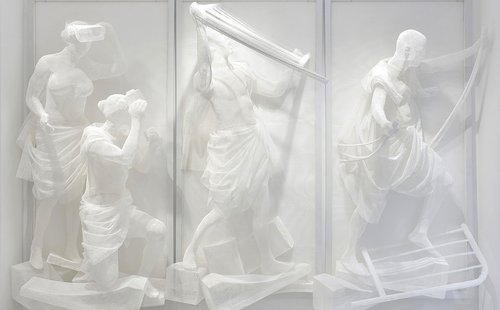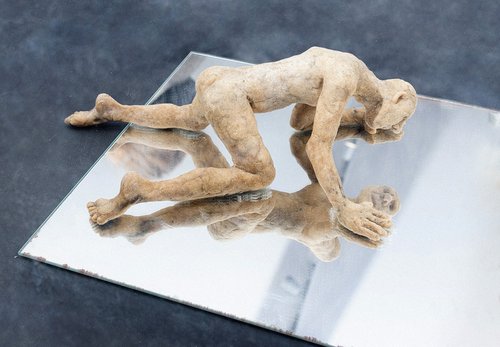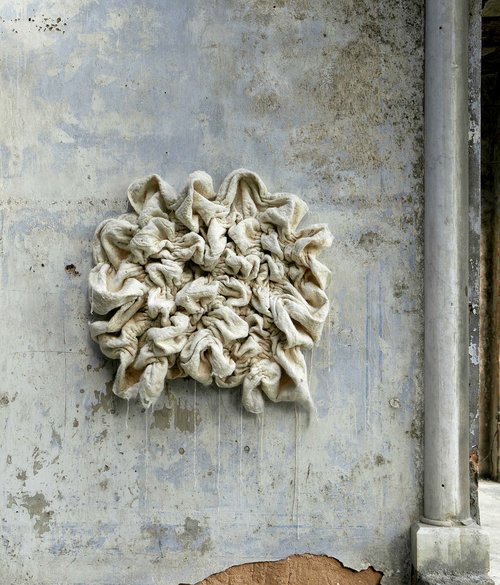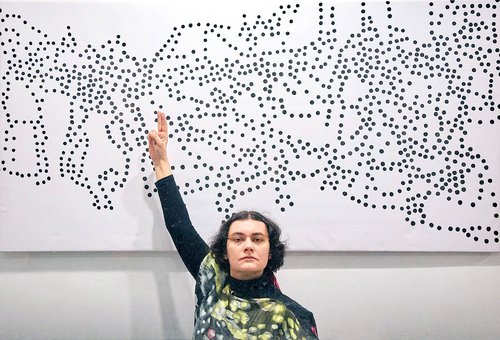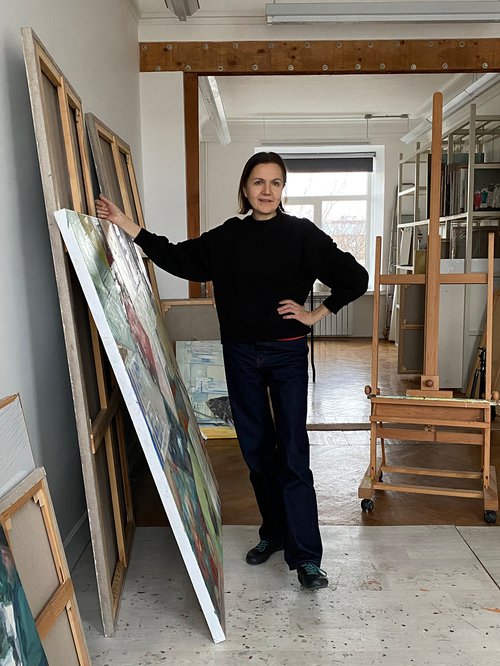Shades of Moscow and Dubai in Paris
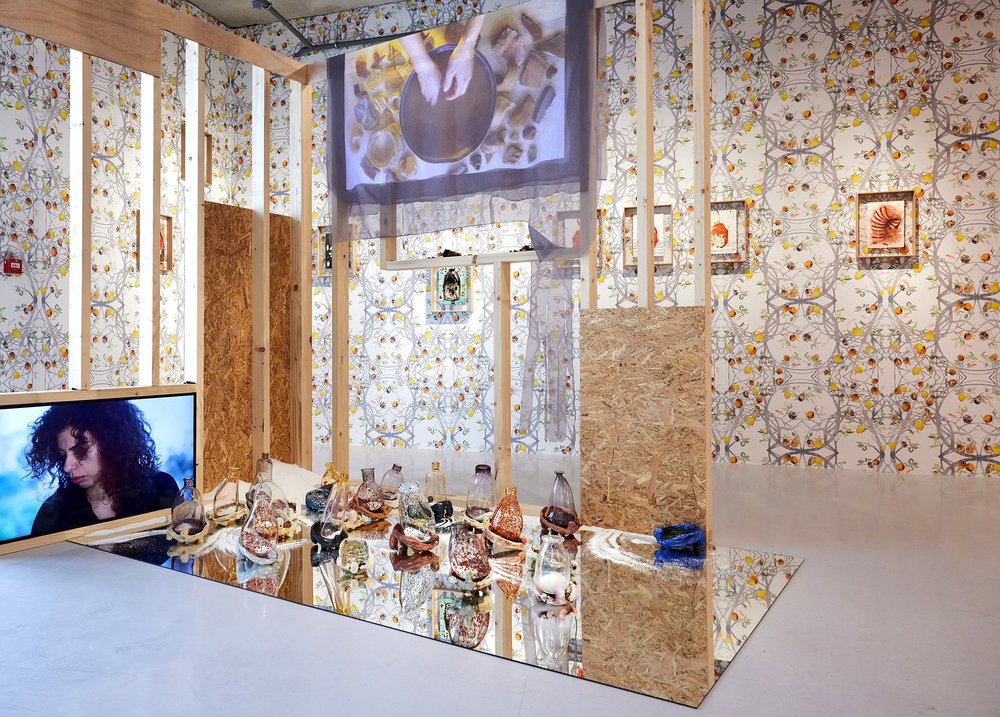
Sour Things exhibition (2024) by Mirna Bamieh at NIKA Project Space, Paris. Installation view. Courtesy of NIKA Project Space
Two galleries specializing in contemporary art from Eastern Europe and the Global South, the Iragui Gallery and the Nika Project Space, have opened new premises in the Fiminco art cluster in the east of Grand Paris.
The Grand Paris is a redevelopment of what was until recently a working-class suburb of Romainville and now is home to one of Europe’s largest cultural clusters. Created by Groupe Fiminco and managed by Fondation Fiminco, the art project opened in October 2019 on the site of the former Gaston Roussel pharmaceutical factories, founded in the early 20th century and eventually taken over by Sanofi. A plan to gentrify greater Paris’s eastern suburbs, La Plaine de l’Ourcq, it applies to five Parisian communes of Pantin, Romainville, Noisy-le-Sec, Bobigny and Bondy, adjacent to the Canal de l’Ourcq.
There is a push to integrate contemporary art with various academic, cultural and commercial sectors, as well as leading architectural firms. Today, the four kilometres from the Parc de la Villette to Fondation Fiminco is not only a former commercial and industrial artery with an industrial atmosphere and extensive construction sites, but also a new cultural district that is reinventing and transforming the idea of contemporary art in Paris.
The Fiminco Art Cluster is the hub of the area’s creative activities. The project currently occupies almost 50,000 m², including five buildings which house a variety of different initiatives, including artist residencies, communities, artist studios and other arts organizations. A monumental boiler room with 14-metre-high ceilings, has been converted into an exhibition space.
Its synergy attracted Ekaterina Iragui, owner of the Iragui Gallery, one of Moscow's leading contemporary art galleries, who has opened her new space in the Fiminco art cluster and become a member of the Komunuma (Esperanto for ‘community’) gallery association. She plans to feature a variety of different formats in her new space, including both solo exhibitions and group curatorial projects. Her main focus will continue be on the Eastern European art scene, supporting its actors and highlighting their unique voices.
St.Petersburg-born Veronika Berezina, founder of the Nika Project Space was attracted by its similarity to Dubai’s Al Quoz industrial district where her gallery has been based since 2023, she noted: “The new space brings us closer to key partners and creates a bridge between the Paris and Dubai programmes,”. Her gallery will continue to focus on the MENA region, the Global South and Europe, promoting artists like Adrian Pepe (b. 1984), Nika Neelova (b. 1987), Alexander Ugay (b. 1978), Polina Kanis (b. 1985), and Katya Muromtseva (b. 1990).
Both galleries chose to debut with solo exhibitions by female artists at their new spaces in Fiminco. ‘Re-Animation’ at Iragui Gallery is a solo show of new work by Olga Chernysheva (b. 1962), one of the most established artist she represents, and an artist with an international reputation and in 2022 Chernysheva was awarded the prestigious French Drawing Prize of the Daniel and Florence Guerlain Foundation. Although known for photography and video, in recent years she has focused on painting and drawing. Her field of interest continues to be images of ordinary people captured in their leisure time, outside work, Boris Groys describing her as “an artist of Sundays, not weekdays”. Beauty is subjective, and Chernysheva carefully seeks out and documents these touching, naive and often clumsy attempts by her characters to aestheticize their everyday life or “moments of artistic behaviour”, as she calls them.
‘Re-Animation’ appears at first glance to address the various different mechanisms of nostalgia. The artist refers to the ephemerality of the animate and inanimate worlds, mixing and equating animal and human figures, objects and old toys. They are united by a common dreamlike mood. “We are made from our dreams,” she says yet at the same time 'Re-Animations is a play on words, referring to Chernysheva's professional experience as an animation cartoon artist, and to her anthropocentric and demiurgic desire to animate objects by endowing them with history and soul.
Guest curator of the exhibition Hervé Mikaeloff did not separate bright paintings and monochrome works on paper, animate and inanimate, close-ups and general views, multi-figure and single-figure compositions, deliberately mixing and combining different characteristic works and thus creating counterpoints of moods and complex rhythmic patterns. On one wall in ‘I and We’ playful birdlike ladies’ shoes chirp “I, I, I, I, I, I, I, I, I, I, I...”, mottled in uneven blue handwriting. Opposite are melancholic elephants muted and supported by a light haze, like a vague memory slipping from the mind. In ‘Stopped Wind’, a hunter and a bear awkwardly balance between shoes and elephants, as if continuing one of the exhibition’s leitmotifs -- ‘anima’ (soul) / ‘animal’ (animal).
Nika Project Space showcases works by Palestinian artist Mirna Bamieh (b. 1983) from her project ‘Sour Things’. Bamieh works with the theme of memory, but not so much personal as collective – tragic, vulnerable and on the verge of extinction, one that needs to be preserved and protected. One of the key visual images in her work is food and the rituals associated with it. Bamieh is also the founder of Palestine Hosting Society, a platform created in 2018 to preserve Palestinian recipes. She created the multi-part project ‘Sour Things’ in 2023. The first installation, ‘Sour Things: The Souq’, was presented in an abandoned 1970s market in Sharjah during the Biennale. The second piece, ‘Sour Things: The Kitchen,’ transported the viewer into the space of an imaginary kitchen. The third, 'Sour Things: The Pantry', has been created specifically for the current exhibition, with support by the Nika Gallery.
In her installation ‘Imagine Home’ (2024) at the Noordbrabants Museum in the Netherlands, Bamieh focuses on the image of the larder, using the processes of fermentation and preservation as a metaphor to reflect on forced relocation, the loss of roots and one's sense of place. Is it possible to prepare for disaster? How do you preserve anything when you no longer have a home and are ‘nowhere’? For Bamieh, the salt scattered in the centre represents a symbol of hope and horizon because these traditions are thousands of years old, and even the most difficult of times can be overcome.
On the surface, many of the works in the current exhibition are bright and cheerful, but this positivity gives way to something darker. ‘Grieving in Colours’, created this year, features still lives of oranges starting the process of decomposition. The image is not only part of her personal history – the port city of Jaffa, where Bamieh's father's family comes from, is famous for its citrus exports – but it also represents an element of her cultural code. Rot and mould have already penetrated the fruit, damaging its tissues. The artist captures this state of agony in an attempt to prevent final destruction.
The installation ‘Sour Cords’ features giant ceramic dried pods of peppers, okra, garlic and cloves assembled in vertical ornamental compositions. Some of the fruits depict childlike drawings, while others have huge eyes. These images are both talismans and shards of disappointment. In this turbulent world full of injustice and suffering, how do we preserve ourselves?
Olga Chernysheva, ‘Re-Animations’
Paris, France
September 8 – October 26, 2024
Mirna Bamieh, ‘Sour Things’
Paris, France
September 8 – October 27, 2024




















